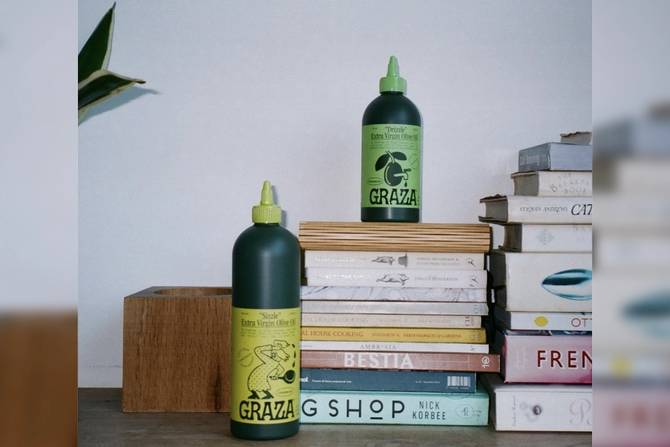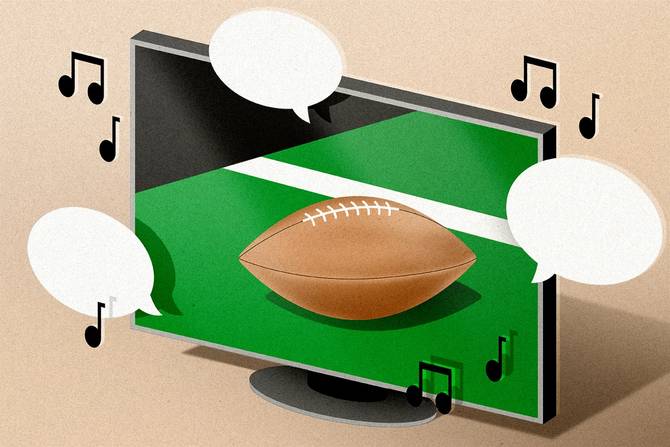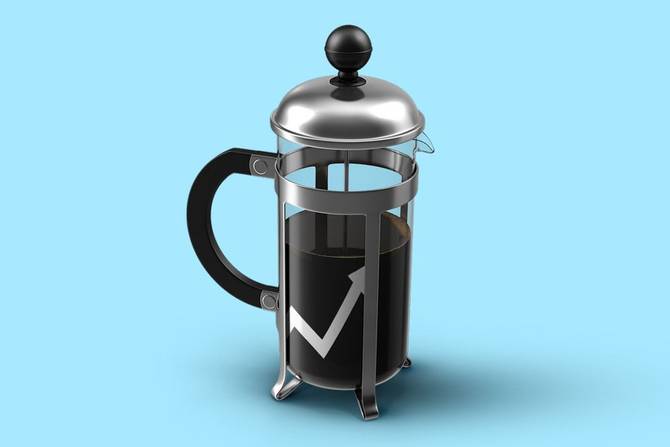Happy Thursday. This may come as a surprise to some of you, but more than one in three consumers have never heard of the metaverse, according to new research. And only 6% of people surveyed said they understood it well enough to explain it.
In today’s edition:
- The art of selling olive oil
- Super Bowl sounds
- Why ViacomCBS ditched its name
—Phoebe Bain, Alyssa Meyers, Kelsey Sutton
|
|
Graza
How much easier would life be if olive oil came in a squeezy bottle?
That’s not only DTC olive-oil brand Graza’s pitch to customers, but also the line used by the brand’s social media consultant, Kendall Dickieson, while trying to court potential influencers.
“I was sliding into people’s DMs with—call it a pickup line—like, one-liners,” Dickieson told Marketing Brew. That one-liner was part of a robust influencer marketing strategy that helped Graza, a squeezable olive-oil brand, sell out following its launch on January 11.
-
Graza’s co-founders, Andrew Benin and Allen Dushi, tapped Dickieson (who is also an influencer in the food space herself), as well as marketing consultant Grace Clarke, to help execute the brand’s strategy for debut.
- Their strategy involved treating retail stores as influencers in their own right, and taking a slower, tiered approach to influencer gifting, starting with smaller creators before building up to macro-level ones.
Retail stores as influencers
Graza worked with influencers on all the usual social channels: Instagram, TikTok, Twitter, etc. But it also collabed with retail stores to get the word out.
“We got to take a really wide view of what influencer and creator meant,” Clarke told us. The team reached out to 80 retailers around the US, offering them samples for customers as well as a few free bottles for employees. About half initially responded, and more came on board after Graza officially debuted. Her team told retailers they weren’t obligated to post about Graza, or do anything at all, in exchange.
You’ve got mail: Graza sent packages to a variety of small retailers, focusing on stores where other olive oil brands probably wouldn’t be sold—like pet stores and kids’ toy stores—under the assumption that their clientele are likely family people. These shops included Two Kids and a Dog in Dumbo, Brooklyn, Miracle Mile Toys and Gifts and Healthy Spot locations in LA, and Mishka Dog Boutique in San Francisco.
“Whether family for them means humans or animals, they are taking care of another creature. And we thought that might mean that they want to spend time building a home and nesting,” she said. For example, she figured parents who cook with children nearby might be interested in Graza’s plastic bottles over traditional glass ones.
Click here to read more about the strategy, including how it worked with creators.—PB
|
|
Francis Scialabba
From visual effects to A-list celebrities, there’s a lot to pay attention to in the elaborate productions that are Super Bowl ads. So it’s easy for elements like music and voice-overs to be overshadowed. Still, for ads that can cost up to $7 million for just 30 seconds of airtime, it’s important to get every detail right.
Marketing Brew asked sonic branding agency amp to analyze the majority of ads that ran in this year’s game to get a sense of how brands made use of audio. We’ve highlighted some of their findings below.
Sad songs are so 2021
Last year’s Super Bowl was more of a muted affair, and that tone was reflected in some of the ads.
-
For instance, Bass Pro Shops and its subsidiary Cabela’s channeled “these trying times” vibes in an ad, using a soft, instrumental track. Similarly, Anheuser-Busch ran a corporate commercial featuring a piano track, along with the phrase “when we’re back,” a sign of pre-widespread vaccination.
“Overall, the general tonality of everything that we’ve seen, the pop tracks, everything else, was a lot more happy and forward-looking and energizing versus last year, where there was a balance of some sad moods, more mellow moods,” Vijay Iyer, CEO of amp sound branding North America, told Marketing Brew.
Break it down: This year, 24% of Super Bowl ads used music that amp classified as primarily “cinematic”—which includes elements like electronic and orchestral tracks—per its analysis. In other words, the type of music typically associated with movie trailers, according to Bjorn Thorleifsson, amp’s head of strategy and research.
-
The music in the Hellmann’s ad, starring Pete Davidson, was categorized by amp as “cinematic,” for example.
Best of the rest: According to amp, the rest was a mix—13% used “pop” music, but other genres, including “rock” and “hip-hop,” got some airtime. And two ads used no music at all (looking at you, Carvana and Greenlight).
Read more here, including how many commercials flew by without a single audible mention of the brand’s name.—AM
|
|
|
We didn’t mean to yell, but weak product content simply won’t build customer engagement. In fact, it’s a turnoff: Only 21% of consumers say they actually trust brands, and with the mountains of bland or misleading content out there, it’s easy to see why.
Pumping up your product content—the text, images, and videos brands use to describe their products—is how you reach customers and build trust. And according to inriver, strong product content leads directly to stronger sales. 
Think of this marketer’s guide as a content-workout plan designed to help you build the accurate, engaging product content your audience wants to see.
And once that product content is in tip-top shape? Share it across all your selling channels to create a strong purchasing journey from beginning to end.
Download the guide and get started today.
|
|
Paramount
Gone are the days of ViacomCBS, the Frankenstein’s Monster-like name stemming from a corporate merger.
Beginning this week, the company—which owns the streamer Paramount+, CBS, and cable properties like MTV and Comedy Central—is rebranding to Paramount. (Technically, the name will be Paramount Global.)
- The corporate rebranding harks back to the company’s roots. Paramount Pictures, one of the oldest studios in the US, was founded in 1912 and was bought by Viacom in 1994. ViacomCBS, meanwhile, was the mash-up of Viacom and CBS Corp. from when the companies—which had merged and split once before—recombined in 2019.
- “Paramount has always represented brilliant storytelling for audiences around the globe—on the big screen, the small screen, and every device in between,” Shari Redstone, the non-executive chair of the company’s board of directors, said during an investor presentation Tuesday. “It is what we are. It is who we are. It is who we are destined to be.”
The rebrand also builds on a decision the company made less than two years ago when it renamed its streaming service from CBS All Access to Paramount+. At the time, then-Chief Digital Officer Marc DeBevoise told me that Paramount is “the most well-known brand we have globally.”
Joe Tradii, a marketing consultant and founder of JAT Consults, told Marketing Brew the new name can build off of consumer affinity for Paramount+ and Paramount Pictures for a quick transition. “Paramount’s got a lot more brand equity than ViacomCBS does,” Tradii said, adding that the name signals entertainment both “classic and new.”
And hey—it’s at least better than the last one. In Tradii’s opinion, ViacomCBS was an “awful stew of a name” that didn’t “stand for anything in the mind of the consumer.”
Full stream ahead: The new name comes as the company continues to bet big on its future as a streaming powerhouse. Paramount+—which is planning a franchise-packed programming strategy—ended its most recent quarter with 32.8 million global subscribers.—KS
|
|
-
Spotify is doubling down on its podcast ads biz with the acquisitions of Chartable, a podcast analytics platform, and Podsights, an ad measurement tool.
-
Meta is reorganizing its comms team as it works to “combat an onslaught of negative press.” Metamates, assemble.
-
Adidas is no longer requiring its US employees to be vaccinated.
-
Truth Social, former President Donald Trump’s social-media app, has reportedly opened to around 500 beta testers.
|
|
|
CMS got a modern makeover. Brightspot has helped transform outdated concepts about web content management systems into an innovative hub for content, digital brand identity, integrations, and data. Want the deets? Brightspot’s guide breaks down what exactly a content hub is, how it’s different from a traditional CMS, and how it can help your team move faster. Download the guide here.
|
|
There are a lot of bad marketing tips out there. These aren’t those.
Super Bowl winner: We’re not talking about the Rams. Morning Consult is out with new research that indicates which SB LVI ads were “most loved.”
Level up: You know how to post pics to Instagram, but have you perfected your video strategy? If not, check out these pointers.
Red flag: B2B marketers use marketing-qualified leads (MQLs) as a metric of success, but here are a few reasons why an overreliance on MQLs can hurt your marketing.
Is this ad gonna work? Before they decided to run with us, ThoughtLeaders crunched the numbers to see if this ad would actually deliver on their campaign goals. You can do the same—whether you’re running in newsletters, podcasts, or YouTube integrations. Download ThoughtLeaders’s free campaign planners to see how.*
*This is sponsored advertising content.
|
|
This one goes out to the CPG advertisers: A recent report from McKinsey outlines four actions you can take to “maximize marketing impact” from the rise of retail media networks (RMNs). Read it in full here, or skim our TL;DR version below.
Step one: Get on the same page as your RMNs about your goals for the partnership.
Step two: Put your money where your mouth is. In order to get the most impact out of RMN efforts, CPG advertisers should “commit meaningful investment commensurate with growth aspirations,” McKinsey wrote.
Step three: Collaborate, don’t just “set it and forget it.” Keep your RMNs, creative agencies, and other marketing partners up-to-date on your expectations.
Step four: Be specific with those expectations. For instance, let your RMNs know exactly what you’d like to see in terms of reporting and data insights.
Zoom out: How did RMNs make a name for themselves in the first place? The shift to e-commerce and the rise of first-party data are partly responsible for sparking interest, according to McKinsey.
|
|
|
You're 2 referrals away from earning Morning Brew stickers.
Don't leave your laptop feeling naked. Cover it up with these Morning Brew stickers.

Hit the button below to learn more and access your rewards hub.
Click to Share
Or copy & paste your referral link to others:
morningbrew.com/marketing/r/?kid=303a04a9
|
|
Catch up on a few Marketing Brew stories you might have missed.
|
|
|
Written by
Phoebe Bain, Alyssa Meyers, and Kelsey Sutton
Was this email forwarded to you? Sign up
here.
WANT MORE BREW?
Industry news, with a sense of humor →
-
HR Brew: analysis of the employee-employer relationship
Tips for smarter living →
 Podcasts →
Business Casual
and
Founder's Journal
Podcasts →
Business Casual
and
Founder's Journal
 YouTube
YouTube
Accelerate Your Career →
-
MB/A: virtual 8-week program designed to broaden your skill set
|
ADVERTISE
//
CAREERS
//
SHOP
//
FAQ
Update your email preferences or unsubscribe
here.
View our privacy policy
here.
Copyright ©
2022
Morning Brew. All rights reserved.
22 W 19th St, 4th Floor, New York, NY 10011
|
|










